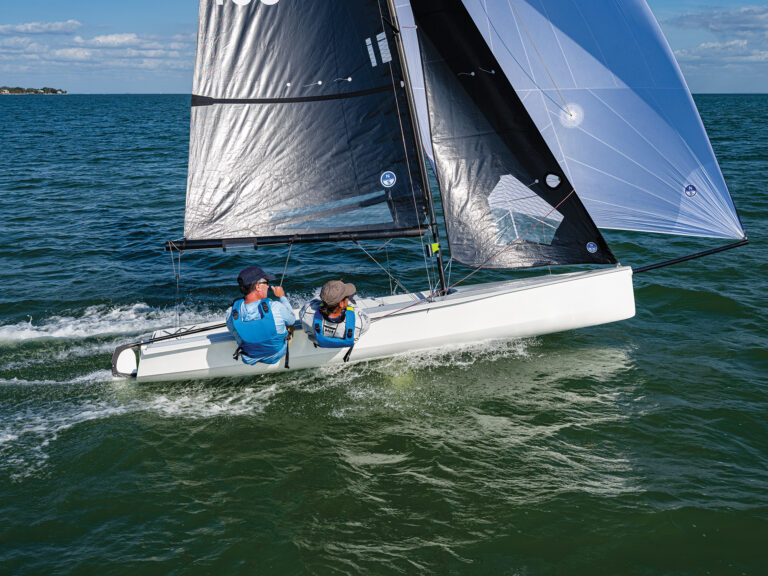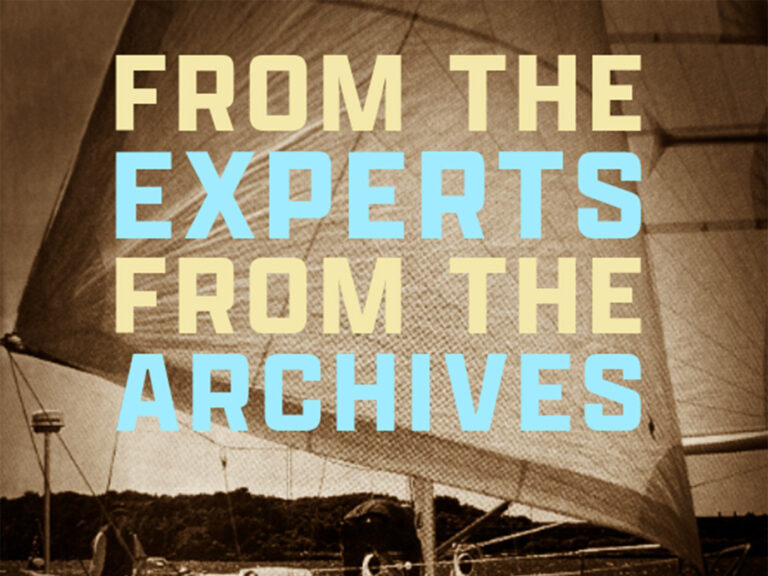Sariyah is on course and at speed. The crew work is becoming smoother all the time and our sailmaker is hard at work down below. All’s well and we’re enjoying warm, sunny weather. It’s another beautiful day in the North Atlantic, windspeeds up around 25 knots with gusts to 30 with boatspeeds up to 12 knots. Yesterday afternoon Dave Guinan set a race record speed of 15.4 knots while steering the boat with a poled out genoa, yankee, full main and half mizzen and wind speeds up to 35 knots. Ever since he set that record the guys on my watch, particularly Blair, have been trying to beat it. It will be hard, because soon after Dave set the record we figured we had too much sail up for the big breeze. It won’t stop us from trying though. Another boat has dropped out, the Spanish entry Ocean Phoenix, which has been steadily dropping behind the fleet. That makes three so far. We’ve also had a report that one of the crew on Sojana has been hurt. We don’t know the extent of his injuries, but we hope he’s OK. Aside from some knocks on the head, a few rope burns, and a slightly sprained hand, we’ve managed to avoid any major boat bites. Although we’re not quite halfway to the finish we’re starting to smell the barn. A pool has been started which will be rewarded to the watch that makes the best VMG to the finish between now and then. In my mind it’ll be my B watch that wins, but we’ll get some good competition from the other two watches, especially Tim and Kevin’s. It’ll be hard to beat a gold medalist and the skipper with 11 years of experience driving Sariyah. We just completed a bit of important maintenance. During a walk around inspection one of the crew discovered that the pin that holds the main boom to the mainmast had worked its way out after three solid days of downwind sailing in big breeze. There were only about two-and-a-half threads left holding the nut on, so it required immediate attention. Even though the boom is made of carbon fiber, it’d be hard, if not impossible, to re-attach it, even if it survived the fall to the deck. Crusty, our engineer, and Dave, along with a few other guys, took care of the problem with a big hammer and a large crescent wrench. Nothing is small on this boat, from the bulbs that go into the running lights to the shackles that hold the sails tacked down. For the first time in many days we saw another vessel late yesterday afternoon. The closest it got to us was about two miles away, and it looked like a large offshore fishing vessel of European heritage. We tried raising them on VHF channel 16, but they weren’t monitoring their radio, a common occurrence on commercial vessels offshore. By the time we get closer to England, the ship traffic should increase a great deal. We’ll spend a lot of time on the radio and monitoring the radio, especially when we reach the crowded waters of the English Channel. Unfortunately time ran out before the guys at Custom Navigation could install our Automatic Identification System, which is one of the more interesting technologies on the market today. AIS is a transmitter hooked up to a ship’s GPS, which sends out information to other vessels equipped with the system. It will tell you the name of the vessel, as well as it’s speed and heading. As I’ve written before in SW, it’s not a replacement for radar, but it’s a great tool for traffic management. Navigation programs such as Nobeltec and GPSNavX have updates their software to allow AIS information to be displayed directly on the screen. The technology aboard has made us feel much more connected to the real world than sailors were only ten years ago. Our Fleet 33 MiniM satellite receiver/transmitter has allowed us to browse the Internet (albeit slowly) send and receive emails, and access the New York YC website for position reports from the rest of the fleet. We take the positions of our closest competition every six hours and plot them on Nobeltec, which gives us a good idea of the other boat’s intentions and ways of thinking, a must for our tactical planning. Every boat in the fleet is equipped with a transceiver which sends speed, heading, and position to the race office, which posts the information to its website. We watched as Mari-Cha IV drifted for twelve hours while effecting repairs to what we guessed was their headboards. “The sailmakers design these headboards to be light,” says Peter Harken. “They just don’t allow for the massive loads they’re under. Sometimes we get these specifications from them and just shake our heads.” We also saw that Stad Amsterdam wasn’t going to finish the race in the month of June, which probably explains why they dropped out. We just put the mizzen staysail back up. It’s interesting to see how smooth the crew work has become. What took us 15 minutes to do six days ago now only takes five. By the time we get to England we’ll be able to do sail evolutions even faster. Carol’s down below fixing one of the other mizzen staysails, which we put some small holes in last night. She’s got a Bruce Springsteen DVD on the big screen, and Bruce is singing about Thunder Road. We’ll continue to thunder down the rhumbline to England.









